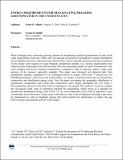Energy Requirements for Desalinating Brackish Groundwater in the United States
Author(s)
Ahdab, Yvana D; Thiel, Gregory Parker; Lienhard, John H
DownloadIDA17WC-57918_Ahdab_.pdf (7.369Mb)
Open Access Policy
Open Access Policy
Creative Commons Attribution-Noncommercial-Share Alike
Terms of use
Metadata
Show full item recordAbstract
Water shortages have motivated growing interest in desalinating brackish groundwater to meet fresh
water requirements. Since the 1960s, only one national assessment of groundwater resource distribution
and availability has been conducted in the United States, and no national assessment has been conducted
on the energy costs required to make brackish groundwater potable. Yet, various organizations have
collected more hydrological and chemical data from the increasing number of wells. Groundwater’s far
more complex and diverse chemical composition, compared to that of seawater, makes a large-scale
analysis of the resource especially valuable. This paper uses chemical and physical data from
groundwater samples, compiled by U.S. Geological Survey in August 2016 from 17 sources for over
100,000 groundwater wells across the United States, to conduct a national assessment on groundwater
composition and desalination energy costs. First, the paper investigates the geographic distribution of
groundwater composition and reveals that composition varies largely throughout the U.S. Then, a
thermodynamic analysis of the least work of separation is developed. This analysis is used to evaluate
the site-specific least work of separation required for desalination, which serves as a baseline for
groundwater desalination energy costs in the U.S. As with composition, least work of separation varies
considerably across the nation. Lastly, areas with both low least work of separation and high water stress
are determined in order to highlight regions that hold potential for desalination to reduce the gap
between high water demand and low water supply.
Date issued
2017-10Department
Massachusetts Institute of Technology. Department of Civil and Environmental Engineering; Massachusetts Institute of Technology. Department of Mechanical EngineeringJournal
IDA World Congress on Desalination and Water Reuse
Publisher
International Desalination Association (IDA)
Citation
Ahdab, Yvana D. et al. “Energy Requirements for Desalinating Brackish Groundwater in the United States,” IDA World Congress on Desalination and Water Reuse, São Paulo, Brazil, October 2017, International Desalination Association (IDA), October 2017.
Version: Author's final manuscript